Niagara Falls attracts approximately 12 million visitors each year. With stunning views, rich history, and plenty of attractions, this destination has something for everyone. This guide will help you make the most of your visit, from crossing the border to enjoying local cuisine.
Crossing the Border
Driving from the U.S. to Canada is straightforward. The most common route is via the Rainbow Bridge. Depending on the time of day and traffic, the border crossing can take anywhere from 30 minutes to over an hour. Be sure to have your passport ready and check for any travel advisories before you go.
Parking Options
Once you arrive, parking is available at several locations near the falls. The best spot is the Niagara Parks Visitor Centre parking lot. It’s centrally located, allowing easy access to the main attractions. Parking here costs around $20 for the day. Alternatively, street parking may be found, but it can be limited and more expensive.
Iconic Boat Ride
No trip to Niagara Falls is complete without experiencing the famous Hornblower Niagara Cruises. This boat ride takes you close to the base of the falls, where you can feel the mist on your face. The ride lasts about 20 minutes and was my favorite thing we did as a kid visiting the falls and also now as an adult. Be sure to wear the poncho they give you, as you will get drenched! On the US side the boat cruise is called the Maid of the Mist.
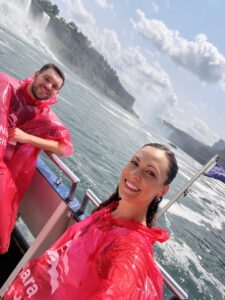
History of Tourism at the Niagara Falls
Niagara Falls has been a tourist destination since the early 19th century. The first hotel opened in the area in 1825, and the falls quickly became a popular spot for honeymooners and adventurers alike. Over the years, the site has transformed into a bustling tourist hub with attractions, restaurants, and shops.
Comparison: Canada Side vs. U.S. Side
When comparing the Canadian side to the U.S. side of Niagara Falls, several differences stand out:
- View: The Canadian side offers a more expansive view of the falls, including the iconic Horseshoe Falls. The U.S. side provides a closer perspective but lacks the sweeping vistas.
- Attractions: The Canadian side has a wider range of attractions, including Clifton Hill, casinos, and the Skylon Tower. The U.S. side features parks and hiking trails, like Goat Island, offering a more natural experience.
- Dining and Shopping: The Canadian side has more dining and shopping options, from casual eateries to fine dining. The U.S. side is more limited in this regard.
- Crowds: The Canadian side tends to be busier, especially during peak tourist seasons. The U.S. side may offer a quieter experience but with fewer amenities.
- Access: Both sides are easily accessible by car, but parking can be more convenient on the Canadian side due to its dedicated lots.
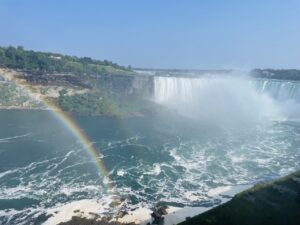
Nearby Town: Niagara-on-the-Lake
Just a short drive from the falls, Niagara-on-the-Lake is a charming town known for its rich history, beautiful architecture, and picturesque landscapes. It features well-preserved 19th-century buildings and is often considered one of Canada’s prettiest towns. Nestled at the mouth of the Niagara River, it offers stunning views of Lake Ontario and the surrounding vineyards. The town is also famous for its cultural scene, including the Shaw Festival, which celebrates the works of George Bernard Shaw and his contemporaries. George Bernard Shaw was an Irish playwright, critic, and polemicist, active in the late 19th and early 20th centuries. He is best known for his plays, which include works like “Pygmalion,” “Saint Joan,” and “Major Barbara.” Shaw was a prominent figure in the literary world and a key proponent of social reforms, often using his writing to address issues like class, gender, and politics.
Must-Try Cuisine: Poutine
While in Canada, you can’t miss trying poutine. This dish consists of French fries topped with cheese curds and smothered in gravy.
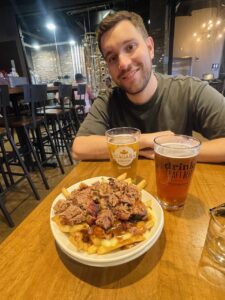
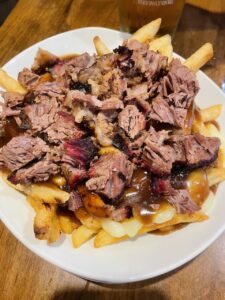
The History of Poutine: A Canadian Classic
Its origins can be traced back to rural Quebec in the late 1950s. Poutine became popular in Quebec during the 1970s and 1980s, spreading across Canada and eventually gaining international recognition. There are several stories about who created it, but two towns often claim to be the birthplace: Warwick and La Salle.
One popular tale suggests that a customer at a diner in Warwick requested fries with cheese curds. The combination quickly caught on. In La Salle, another version tells of a similar dish being served in a local pub, leading to its rise in popularity. Regardless, its appeal lies in its comforting, indulgent nature, making it a favorite late-night snack and fast food option.
Local Brewery: Niagara Falls Brewery
For beer lovers, the Niagara Brewing Company is a must-visit. Founded in 2015, this brewery features a variety of craft beers inspired by the local area. They offer tours and tastings, making it an excellent stop for a refreshing drink after your adventures. Popular selections include the Niagara Gold Lager and the Fallsview IPA.
Popular Attractions and Museums
In addition to the falls, the area boasts several attractions worth exploring:
- Clifton Hill: This vibrant street is filled with arcades, restaurants, and attractions like the Ripley’s Believe It or Not! It’s a great place for families.
- Skylon Tower: For stunning panoramic views of the falls, visit Skylon Tower. The observation deck offers breathtaking vistas, especially at sunset.
- Butterfly Conservatory: Located in the Niagara Parks, this conservatory is home to thousands of butterflies. It’s a serene escape into nature.
- Niagara Falls History Museum: Learn about the area’s past, including the history of the falls and their significance to local culture.
Best Time to Visit
The summer months (June to August) attract the most visitors. If you prefer fewer crowds, visit in spring or fall. The weather can vary. Summers are warm, while winters can be quite cold. The Hornblower and Maid of the Mist typically do not operate during the winter months. Ice formations can be seen around the base and edges of the falls, but the powerful moving water does not freeze during winter.
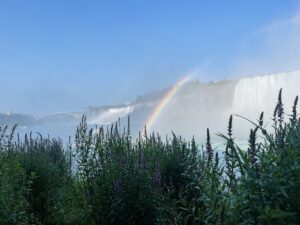
Fireworks Show
From May to October, Niagara Falls hosts fireworks displays on weekends and holidays. The best viewing spots are from the Queen Victoria Park or along the Niagara Parkway.
Souvenir Ideas
There are endless souvenir shops selling mugs, sweatshirts, keychains, magnets and other typical knick knacks. I recommend picking up maple-flavored treats. Maple syrup, candies, and candles are popular options.
Behind the Falls
The Journey Behind the Falls attraction was developed in the late 19th century to provide visitors with a unique perspective of Niagara Falls. Construction began in 1880, involving workers blasting through bedrock using dynamite to create tunnels behind the falls. Completed in 1881, the attraction allows guests to walk through these tunnels and view the powerful water up close. Over the years, it has been enhanced with safety features and visitor facilities, making it a popular way to experience the falls from a distinctive angle.

The Ever-Changing Falls: Erosion and Transformation
Niagara Falls is constantly changing due to natural erosion and geological processes. The powerful flow of water, combined with ice and weathering, gradually wears away the rock at the base of the falls. Over time, this erosion causes the falls to recede at an average rate of about one foot every ten years. Interestingly, the falls are believed to have formed thousands of years ago during the last Ice Age, and they have been steadily moving upstream ever since.
Conclusion
We visited the Niagara Falls for a weekend family vacation when I was 8 years old and the experience was so memorable that decades later I remembered it. I recommend to fully enjoy the falls, visit for a weekend but with careful planning a day trip to Niagara Falls, Canada is feasible. Whether you’re enjoying local cuisine, taking a boat ride, or simply soaking in the views, your visit will be one to remember.
Check out our other adventures:
Running a race in Disney World
